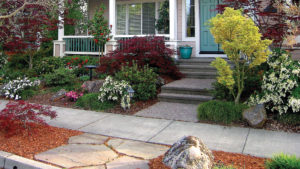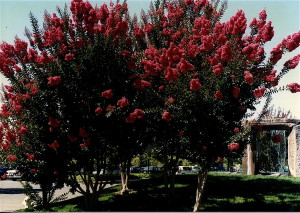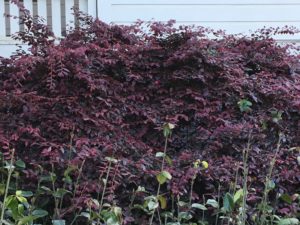Details Landscape Art, a Sonoma County landscape design-build contractor, creates gardens that look amazing all year long. And one of the keys to success is a planting scheme that shows color in each of the four seasons.

In earlier posts we discussed color in the foliage, where clients looking for colorful, low maintenance gardens can achieve their goals with out high maintenance flowers and perennials. Some of these colorful foliage plants are deciduous and show little in the colder months. So to supplement in the off-season, there are a variety of plantings that yield colorful bark, foliage or blooms. There are thousands and thousands of plants out there; following is a list of our favorite plantings, by season, that ensure a yearlong beautiful garden. Keep in mind that the delineation of the seasons is arbitrary…many blooms overlap seasons, so this is a ‘more or less’ seasonal discussion.
Spring:
‘April showers bring May flowers’ – is an old time ditty. Except here in the North Bay, it’s more like ‘February showers bring March flowers’. The timing of the seasons is definitely changing; whether due to global warming or not, nature seems to be fooled, and plants are going through their annual cycles in unusual patterns. In spring, all deciduous trees, shrubs, and ground covers are coming out of winter dormancy. Most begin leafing out, and then blossom at different times of spring or summer. Some, such as Cercis Canadensis ‘Forest Pansy’, actually bloom first on naked branches, followed by burgundy colored heart shaped leaves.

Spring is probably the most colorful season. Plum trees begin the show, followed by the other fruit trees such as apple, cherry and pear. Most of the afternoon shade-loving plants are blooming this time of year, such as azaleas, rhododendrons, pieris, camellia (japonica), and lorapetalum. Spring is easy for a Sonoma County landscape design-build contractor.
Summer:
The warmer months are also full of abundant blooms. This is the time for roses, hydrangeas, star jasmine, rosemary, and many of our favorite perennials such as nepeta, Santa Barbara daisy, salvia and lavender. The list is endless, but mixing spring and summer blooms among colorful foliage plants is easy. The challenge comes in fall and winter.

Fall:
For the most part, fall color comes from deciduous trees losing their chlorophyll and turning red, yellow and orange in a variety of hues. (See our earlier blog about fall foliage).

Our favorite blooming plant in September is the crape myrtle – both the tree and shrub form. We only use the crape myrtle varieties with Indian tribe names (because they are powdery mildew resistant), such as Tuscarora (fuschia color), Catawba (purple), Muskogee (lilac), Natchez (white), Tonto (red), Sioux (mid-pink), and Arapahoe (red).
Winter:
Winter is definitely a challenge, as deciduous trees and shrubs are dormant, as are most perennials. All is not lost however! The bark on the ‘Sango kaku’ Japanese maples turns a coral red in winter after the leaves have dropped. Different varieties of Camellia sasanquas bloom at various times throught the winter. Nandina ‘Firepower’ turns a vivid red with the winter chill. And sarcococca ruscifolia, one our favorite full shade plants, yields extremely fragrand white flowers in January-February, followed by colorful dark red berries. Then Manzanita ‘Howard McMinn’ begins blooming in February. Certain ceanothus and some abutilons also begin blooming in late winter. And most of the shade loving helleborus flower in winter.
Gardens can be colorful throughout the year! Just ask Details Landscape Art – a Sonoma County landscape design-build contractor.
